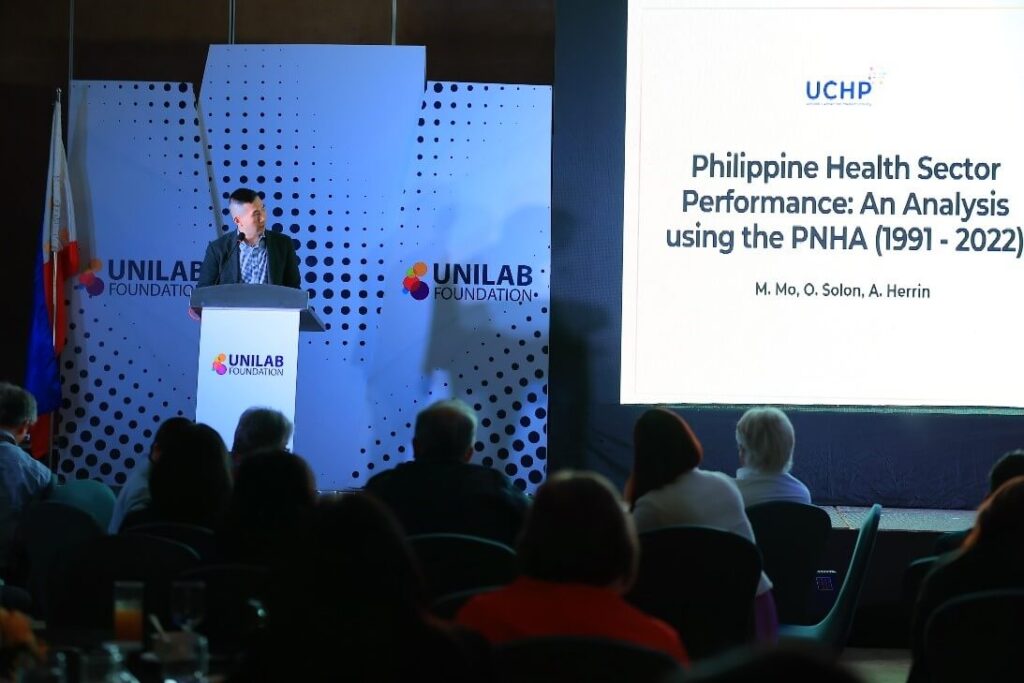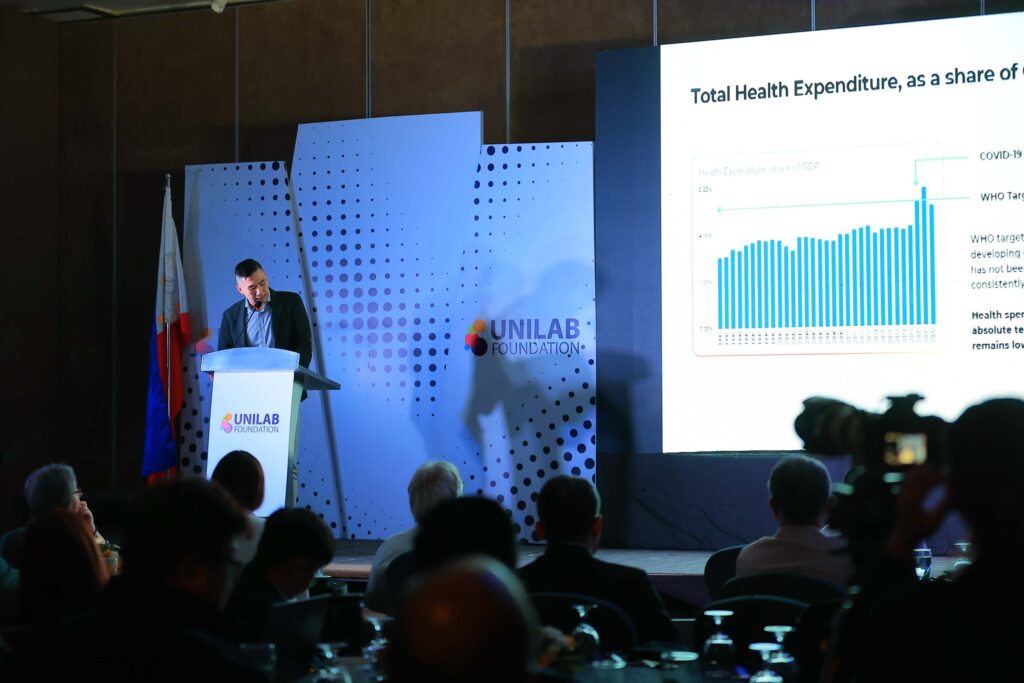
Written by: Tina Arceo-Dumlao
Over the past 30 years, the Philippines’ total spending on healthcare has increased significantly, from only P40.3 billion in 1991 to P1.1 trillion in 2022.
Unfortunately, out-of-pocket expenses for healthcare of Filipino households likewise rose over that period, to the point that these accounted for close to half of the country’s total medical-related expenses by the end of 2022.
In contrast, national and local government spending hardly grew over three decades, with social health insurance or coverage of the Philippine Health Insurance Corp. (PhilHealth) – which is mandated to provide medical coverage – contributing a share of just 14 percent in 2022, far below the ideal level of at least 30 percent.
This despite the series of policy actions and passage of key legislation such as the Universal Health Care Act of 2019 that were supposed to widen as well as deepen healthcare coverage and thus reduce the financial burden on Filipinos, especially the poor with low incomes and usually the highest healthcare requirements.


Philippine Health Sector Performance: An Analysis Using the Philippine National Health
Accounts (1991-2022) presented by Dr. Michael Mo
These were among the major findings of a study on the Philippine National Health Accounts from 1991 to 2022 conducted by Prof. Orville Solon, former Dean of the School of Economics of the University of the Philippines-Diliman, former Prof. Alejandro Herrin and Dr. Michael Mo to determine the trends and impacts of government reforms to improve health spending.
The groundbreaking research paper was one of the two studies released recently by health think tank Unilab Center for Health Policy, a program of Unilab Foundation, that underscored the need for reforms in public health expenditures, including the state insurer’s benefit payments system, to lower Filipinos’ out-of-pocket medical expenses.
The analysis of 30 years worth of health data were unveiled in an executive symposium attended by key stakeholders in the health sector, including representatives from the local and national governments, Congress, health care providers and patients’ groups.
This is part of UCHP’s commitment to provide a forum for an exchange of ideas for the improved implementation of the country’s Universal Health Care policy.
Dr. Mo stressed during the public presentation of the research’s findings that Filipino households’ out-of-pocket expenses are high because public spending has been low over the past 30 years, putting the Philippines behind most of its neighbors in the region when it comes to public spending on healthcare. The study likewise revealed that Filipinos spend much more for inpatient care than outpatient services. Thus, efforts to bring down out-of-pocket payments should be directed at significantly reducing expenses for inpatient care.

(L-R) Panel discussion moderator Dr. Leizel Lagrada-Rombaua, Hon. Trina Alejandra Q.
Firmalo-Fabic, Mayor of Odiongan, Romblon and UCHP Expert Panel; Josef de Guzman, Board
Member of the Medicines Transparency Alliance (MeTA) Philippines; Mr. Mark C. Pascasio,
Officer-in-Charge and Assistant National Statistician for the Macroeconomic Accounts Service,
Philippine Statistics Authority; Dr. Cenon Alfonso, Dean of Ateneo School of Medicine and
Public Health; and Dr. Lester M. Tan, MPH, MSC, Director for DOH Health Policy Development
and Planning Bureau
Health Secretary Teodoro Herbosa said in his speech during the symposium that the national government was contributing to this effort by investing in the opening of more Bagong Urgent Care at Ambulatory Centers (BUCAS) across the country, to bring healthcare services closer to the people who need them.
This way, Filipinos needing medical attention, especially those in rural and remote areas, need not travel far and wide to city or regional hospitals just to see a doctor and have needed tests taken. This will not only reduce their expenses but will also likely lead to better outcomes since they can be attended to earlier rather than later.
Another way to reduce out-of-pocket expenses is to pursue the immediate and smooth adoption of the diagnosis related groups (DRGs) mechanism for determining PhilHealth benefits payments coursed through the hospitals and move away permanently from the current case rates system.
While the case rates system is easier to implement since there are fixed rates for specific ailments and applied across all public hospitals (the set payment package for cancer in Metro Manila, for example, will be the same in a hospital in Sultan Kudarat), the DRGs system is more realistic, nuanced and promises to be more equitable for hospitals and the public that they serve.
This is because with DRGs, more factors will be taken into account, including age and gender and even length of stay so that the benefits packages will no longer be one size fits all.
With all these added factors, a more accurate picture of the actual expenses and therefore coverage of PhilHealth will be provided. With the increased PhilHealth outlay, the out-of-pocket expenses of the patients should therefore be reduced.
Shifting to a new system based on diseases or diagnoses, however, will be far easier said than done, based on the research made by Dr. Valerie Gilbert T. Ulep, Senior Research Fellow of the Philippine Institute for Development Studies, who studied how countries such as Thailand, Australia and Germany successfully implemented the DRGs mechanism in extending healthcare benefits.
(L-R) Dr. Leizel Lagrada-Rombaua of the Department of Health Policy and
Administration, UP Public Health; Engr. Emer Rojas, Global Cancer Ambassador of the New
Vois Association of the Philippines; Dr. Jacinto Blas V. Mantaring III, Expert Panel Member of
the Department of Science and Technology – Health Technology Assessment Division; Dr. Jose
Rene De Grano, President of the Private Hospitals Association of the Philippines; Dr. Imelda
Mateo, President of the Philippine College of Physicians; and Dr. Thea Arcely R. Gimenez,
Member of the PhilHealth Board of Directors. The panel discussed the challenges that may
arise in adapting a Diagnosis-Related Group (DRG) system from their respective organizational
perspectives and explored strategies for effective implementation in the Philippines as a
means to reduce out-of-pocket spending.
According to Ulep, whose study was the second released by the Unilab Center for Health Policy, developing an accurate and transparent methodology for determining the DRGs was an imperative, the basic requirement to make the new mechanism work and implemented as early as next year.
“The resulting global review of best practices showed that the establishment of an accurate and transparent methodology provides for a credible and collaborative engagement among concerned stakeholders,” the researchers noted, “In the countries studied, independent technical institutions with the sole objective of overseeing provider payments were established.”
The Philippines, the research said, can learn from the experiences in other countries on how best to validate costing methodologies. PhilHealth, in particular, should take note and step up since it is vested with the mandate to raise premiums, determine benefits and pay for them.
Clearly, significant work still needs to be done to achieve the overarching goal to reduce the burden posed by healthcare on Filipinos.
The UCHP, however, has helped provide the healthcare sector stakeholders with extensive research that can be the starting point for further discussions that should ultimately lead to a series of actions and reforms that will make quality healthcare more affordable for the greatest number of Filipinos.
This article is brought to you by Unilab Foundation, Inc.

